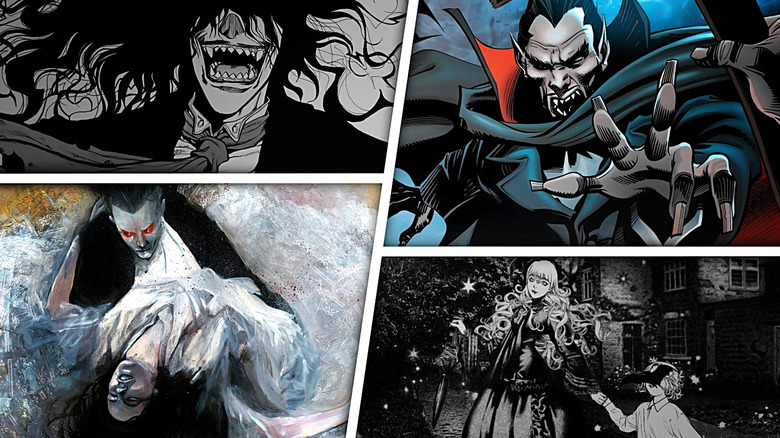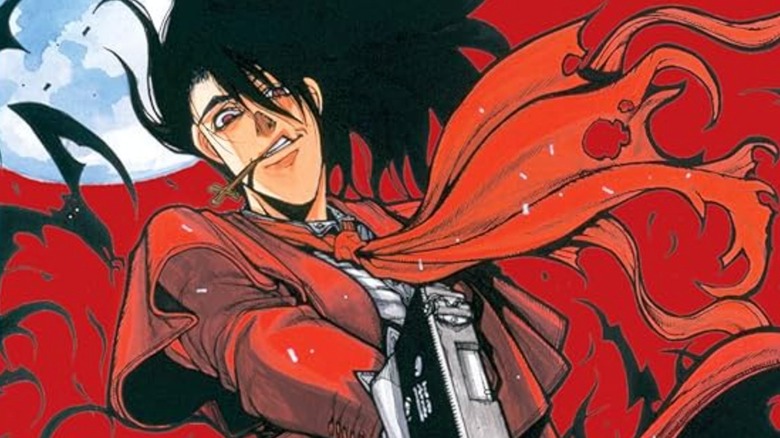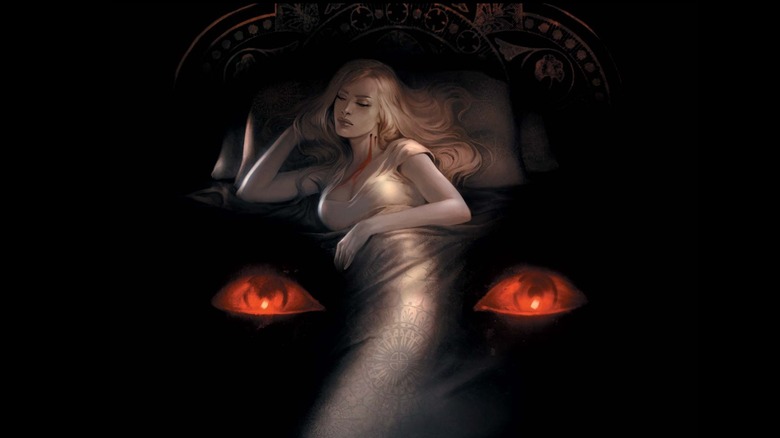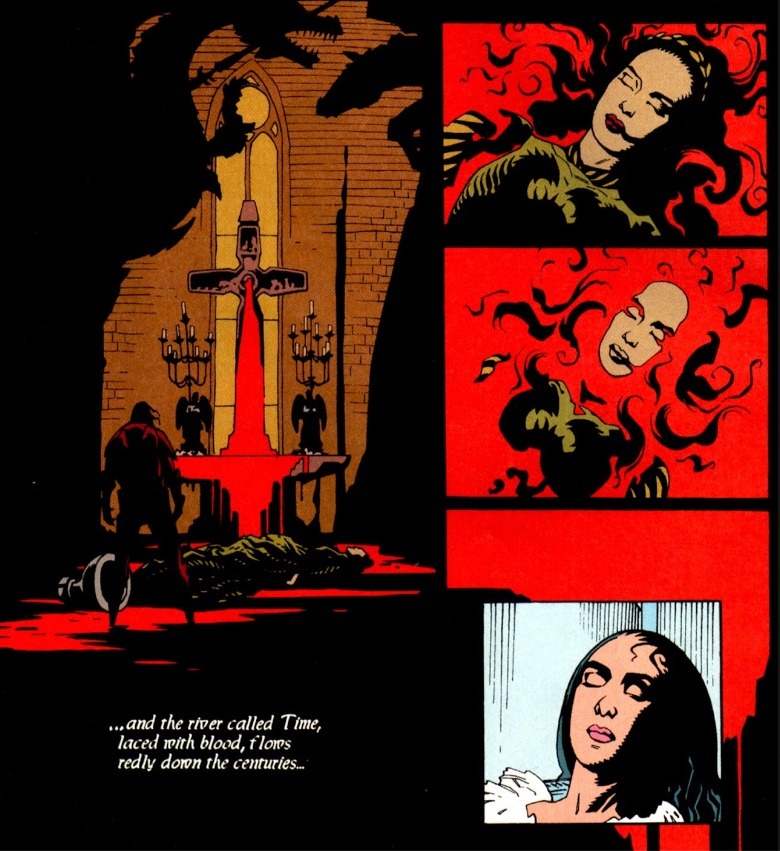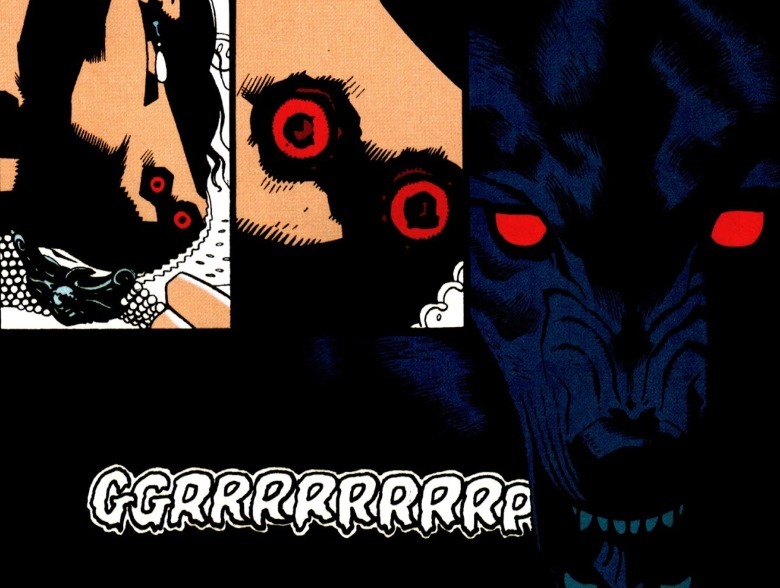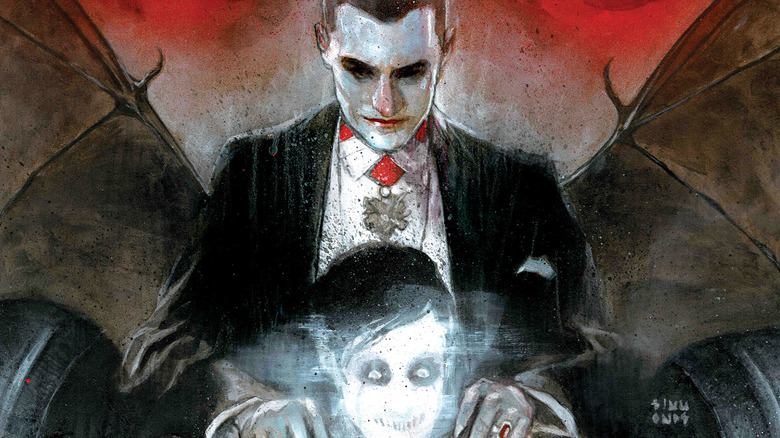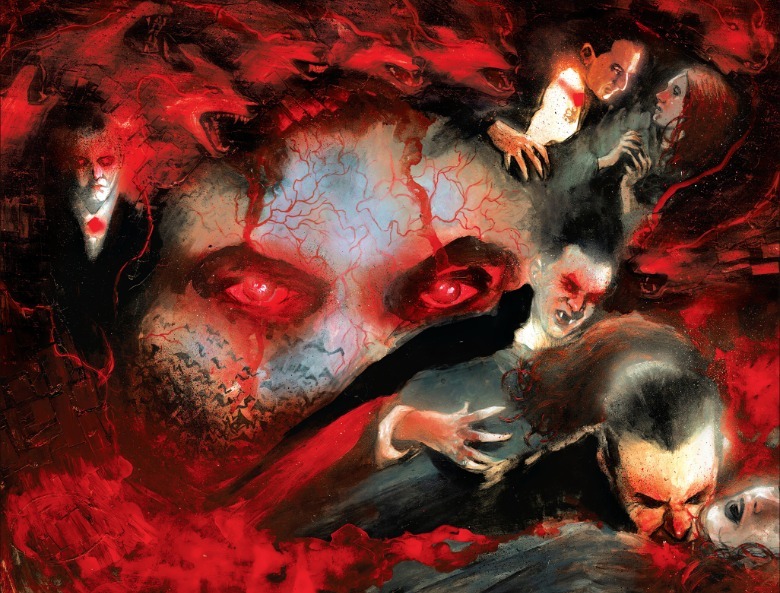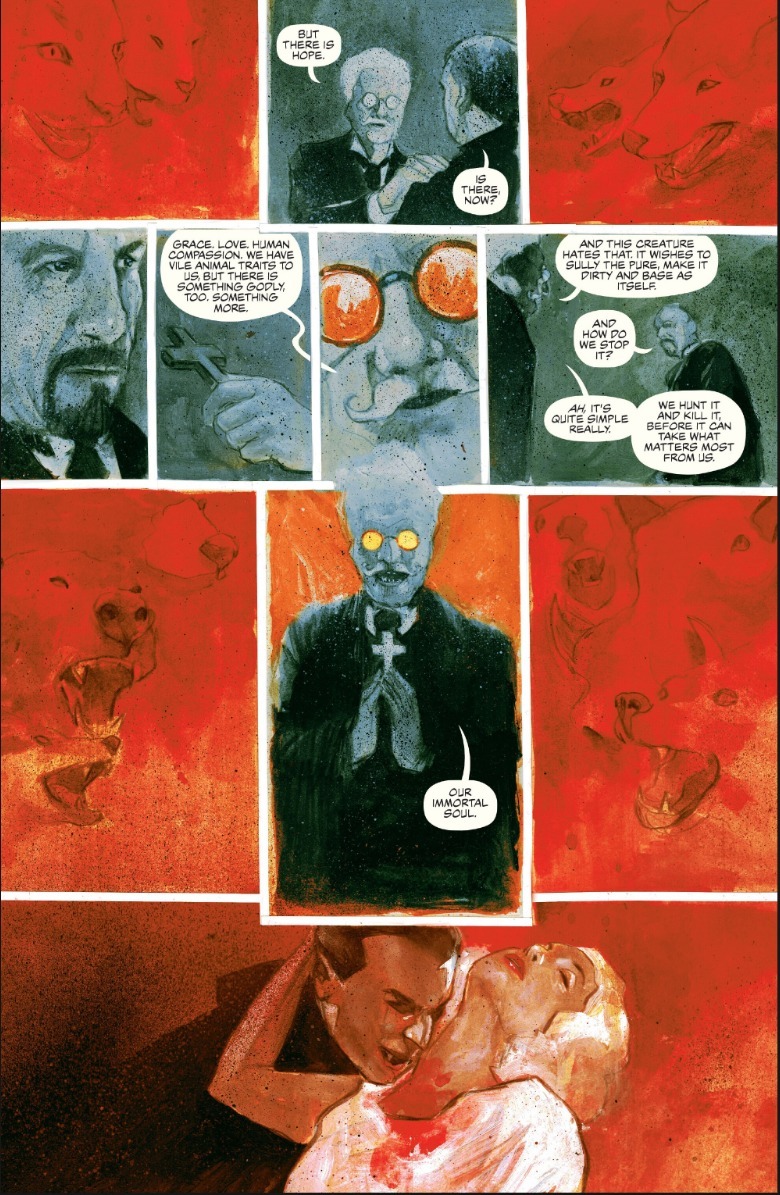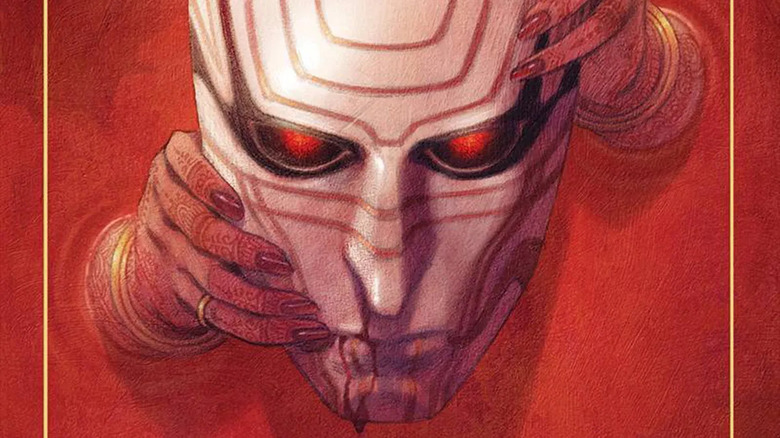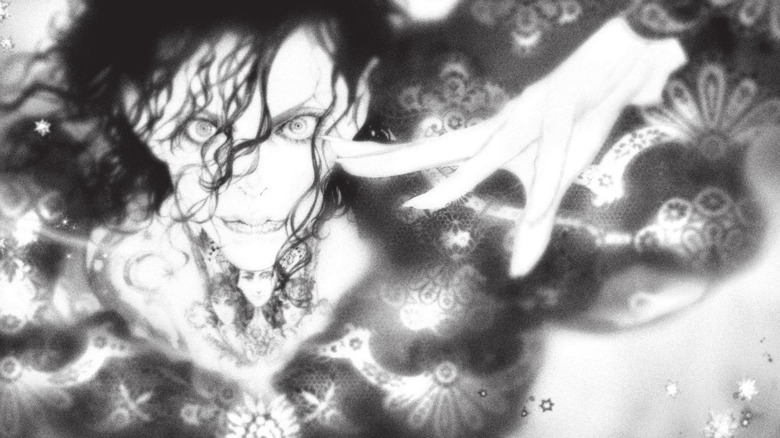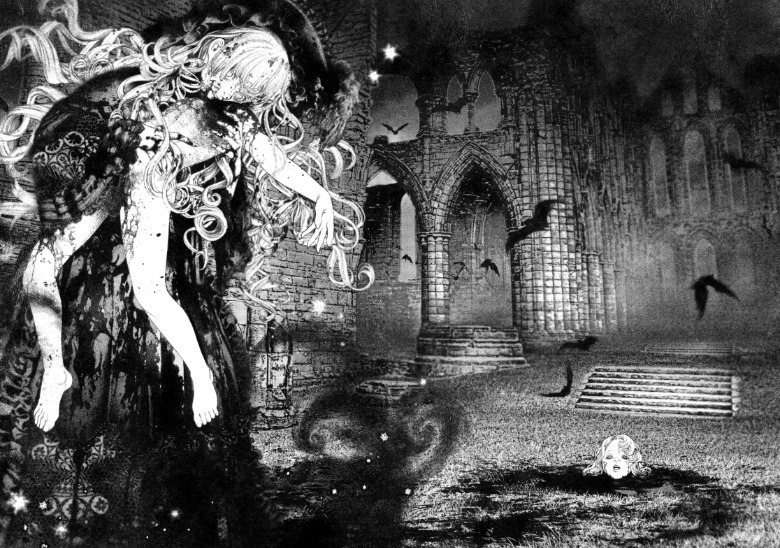The 5 Best Dracula Comics, Ranked
Count Dracula made his debut in Bram Stoker's 1897 novel but the Count's presence on the silver screen has been just as vital in making him a horror icon. Bela Lugosi, Sir Christopher Lee, Gary Oldman, and Nicolas Cage are just a few of the actors who've played Dracula. With the dozens of Dracula movies out there, what's the cream of the crop? We've got you covered with /Film's choices for the best Dracula movies.
But the vampire lord's adventures don't end at movies; he is just as much a creature of the funny books. He's quite similar to Frankenstein's Monster that way, who has also starred in plenty of comics. Dracula has faced superheroes on both sides of the Marvel/DC divide, from Batman to Wolverine (rapid healing blood is the most delicious).
Argentinian cartoonist Alberto Breccia turned Dracula into a gothic comedy bravely satirizing the fascist Chilean dictator Augusto Pinochet. Writers Kurt Busiek & Daryl Gregory and artists Scott Godlewski & Damien Coucerio made the phrase "corporate vampire" literal with "Dracula: Company of Monsters." This year's forthcoming "Dracula: The Impaler" (by Matt Wagner and Kelley Jones) is the first of four planned volumes combining the historical Vlad Tepes with the literary Dracula.
With so many Dracula comics out there, one can feel blind as a (vampire) bat choosing them. So, which should you sink your teeth into first?
5. Hellsing by Kouta Hirano
A gun-toting Dracula fighting legions of Nazi vampires? I've heard worse ideas and the manga "Hellsing" turns it into a sumptuous splatterfest.
"Hellsing" (what a title!) is written as a century-overdue sequel to "Dracula," where the lord of the vampires serves descendants of Abraham Van Helsing. Renamed "Alucard" to signify his turn to good, he and the Van Helsings have forged a vampire-hunting organization loyal to the Church of England. While the premise suggests a monster-hunting procedural, "Hellsing" turns into more of a war epic once another old enemy of England's resurfaces.
Hirano's greatest strength as an artist is absolutely his character designs. Every detail of Alucard's look sings; his red overcoat and wide brim hat. His soulless eyes hidden behind orange shades, beneath which sits a ravenous smile. The pair of guns he wields, far too heavy for any normal human to use.
Granted, I think it took an anime to perfect "Hellsing." The series revels in gore, whether inflicted by the heroes or villains, and that effect is sharpened when the blood Alucard leaves behind (plus his so-fine jacket) are in red. Hirano's manga, though, remains that anime's foundation and one of the most unique Dracula adaptations out there.
"Hellsing" is available from Dark Horse Comics as both a 10-volume paperback set and three volume oversized hardcover editions.
4. Dracula by Roy Thomas & Dick Giordano/Mike Mignola
Some "Dracula" comics reimagine the character in a new setting, others simply retell Stoker's novel. See French artist Georges Bess' black-and-white "Dracula" graphic novel, which was published in 2023 and is part of a spiritual trilogy formed by the comic retellings of "Frankenstein" and "The Hunchback of Notre Dame."
Prolific comic writer Roy Thomas has adapted the original "Dracula" story not once, but twice. (Maybe Thomas will start lobbying for a co-creator credit on Dracula soon.)
Thomas first adapted Stoker in the 1970s as a serialization, published in the short-lived magazine "Dracula Lives!" Drawn by Dick Giordano, this "Dracula" was left unresolved for decades until 2004, when Marvel published it as the four-issue "Stoker's Dracula." In 2010, the series was rereleased in full-color.
During that limbo, Thomas also penned the 1992 comic adaptation of Francis Ford Coppola's film, "Bram Stoker's Dracula." We at /Film are big fans of that movie, one of the most audacious visual splendors ever captured in celluloid. How could any comic match that majesty? Easily, just get Mike Mignola to draw it.
Thomas & Giordano's "Dracula" is the best bet if you want only to experience the novel in a visual form. Giordano's classical, Marvel-house style art resembles a pulp novel cover you might've seen affixed to a 1970s reprinting of "Dracula" — only the interior pages live up to that curiosity-piquing image. The comic is equally worth reading in color and the spookier black-and-white, too.
As for the Mignola edition, those four issues are a simple adaptation of the Coppola film; Mignola draws the characters resembling the film's actors, recreates scenes wholesale, etc. What the comic lacks in surprises, it makes up for in craft. The heavy shadows mixed with the full-out color drenching (colorist Mark Chiarello uses heavy blues for night time scenes) replicate the visual language of Coppola's film. Mignola adds comic-original flourishes too, particularly with transitions. See how, during Dracula's transformation, his bride Elisabetta is consumed by a pool of blood — leading to a panel of the slumbering Mina centuries later, signifying the reincarnation. Or how a close-up of the red puncture wounds adjourning Lucy's neck become Dracula's red eyes.
Both editions of Thomas and Giordano's "Dracula" are available to read on digital reading service Marvel Unlimited. The Mignola version is unfortunately out of print at the moment.
3. Universal Monsters: Dracula by James Tynion IV and Martin Simmonds
One of the more recent Dracula comics was Skybound's kick-off of its "Universal Monsters" meta series. These four issues definitely got the project off on the right foot.
"Universal Monsters: Dracula" is written by James Tynion IV (who jokes in his introduction about how he previously wrote a different comic about a Bat man) and drawn by Martin Simmonds. The mini-series emphasizes how Skybound is specifically working with the Universal monsters; this "Dracula" comic adapts the Tod Browning-directed "Dracula." Simmonds draws the characters like their actors in that film (Lugosi as Dracula, Edward Van Sloan as Van Helsing, etc.) and some shading choices suggest black and white film. What those movies didn't have, though, was red coloring for blood; Simmonds brings that, alternating between classical bronze and phantasmagoric red-black.
Simmonds draws in the style of paintings, not cinematography. Scenes in "Universal Monsters: Dracula" stretch across time and space, sometimes even within the same panel. Take the comic's first major splash page; Dracula starts on the left hand side, then migrates over to the right side (and his first victim) in the form of a bloody-red wolf. Dracula's actions encircle his own piercing gaze; this sort of surrealism takes a pencil, not a camera.
My favorite page in the book is doubtlessly when Van Helsing explains Dracula's weaknesses lie in human hearts. The page outline is structured like a cross; the panels of Van Helsing are colored bluish-gray and surrounded by panels of red beats. The crucifix symbol is the only thing that can keep out Dracula's evil, even as monsters besiege it from all sides.
The comic oscillates between more classical formalism and drawings that breaks the bound of it. The very first page is a nine-panel grid of Dracula's servant Renfield; the first panel is a close-up of a fly he's about to eat, for Renfield has chosen to serve the lord of the flies. Simmonds depicts Renfield as near inhuman with a glowing skull-like face, as if he's among the walking dead like his master but lacks the glamor to conceal it. Renfield, though, achieves redemption because the light of Mina's innocence snuffs out the shadow Dracula cast over him.
"Universal Monsters: Dracula" is available from both retailers in print and digital form.
2. These Savage Shores by Ram V, Sumit Kumar, Vittorio Astone, and Aditya Bidicar
"These Savage Shores" is not technically a Dracula story; the Count himself doesn't show up. It is, though, a vampire comic deep in conversation with Stoker's novel (the writer admits so). As such, I feel it counts — especially since it's really damn good.
The comic is set in 1766 India during English colonialism dominance. British businessman Alain Pierrefont is sent to India; he's a vampire in an allegorical and literal sense, intending to pilfer all that catches his eyes. When he tries to feast on local woman Kori, he meets a swift end at the hand of Bishan, protector of the local prince and an Indian monster known as a "raakshas." Beasts with human faces are not exclusive to England.
The story is an echo of "Dracula," with Pierrefont's voyage mirroring Jonathan Harker's journey to Transylvania. He just brings the ill-intent with him instead of finding it. The narration of "The Savage Shores" is also presented in the form of letters written by the characters describing their experiences (complete with cursive lettering befitting the time period). When Bishan journeys to England in the fifth and final issue, he receives a letter from vampire Signor Grano worded almost identically as Dracula's letter to Harker.
The original "Dracula" is often thought of as a novel about English xenophobia; a foreigner comes to the homeland to spread plague and take their women. In "These Savage Shores," the vampire is also an invading force but with the context flipped; the British Empire is the invader, not invaded. Colonizers, who take land, resources, and culture to fatten their own coffers, are the ultimate vampires.
Stoker himself was Irish, not English, by birth but he lived much of his life in London. He supported Irish home rule but not full independence from Britain. Stoker hailing from a British colony means I won't call "These Savage Shores" an outright reversal of perspective, though it absolutely takes it a step further.
"These Savage Shores" is available from both retailers in both print and digital form.
1. #DRCL Midnight Children by Shin-ichi Sakamoto
While I'll sing the praises of "Hellsing," it's recently been usurped as the best Dracula manga. Shin-ichi Sakomoto's ongoing manga "#DRCL Midnight Children" was recently named the best new manga by the American Manga Awards. I must agree.
The story retells "Dracula" out of order (starting with the last voyage of the Demeter) and with one major difference. The primary characters — Mina, Jonathan, Lucy and her suitors, etc. — are teenage schoolchildren, with Van Helsing as a professor. Don't worry, there's little new melodrama, but the characters' young ages makes them feel even more vulnerable.
Sakomoto's dreamy black-and-white art feels too beautiful to be of this world. The soft, shoujo faces he bestows on his characters makes the bursts of violence (such as the turned Lucy walking with a young boy one moment, then ravaging his decapitated corpse the next) even creepier.
One surreal sequence sees Mina sitting alone in a theater, watching Dracula dance across the stage. The paneling and fade filter on the panels suggests early 20th century cinema, just as Francis Ford Coppola's "Dracula" film grounded its special effects in the period of its setting.
This might be the most ethereal Dracula yet; he's rarely glimpsed in a humanoid form, but instead as a living shadow, or disembodied eyes, or a fearsome dragon soaring over London's skies. Sakomoto has plenty more of the novel to adapt and I can't wait to see what dark shadows he'll take these midnight children into next.
The first two volumes of "#DRCL Midnight Children" are available in print, digital editions, and to be read for subscribers on the VIZ Media website. The third volume is set for U.S. release on September 17, 2024.
